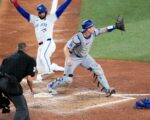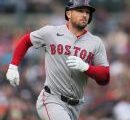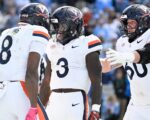The NBA is currently experiencing an era of remarkable parity, with seven different champions over the last seven seasons. Since Kevin Durant was part of the Golden State Warriors, no defending champion has even made it back to the conference finals, let alone claimed the Larry O’Brien Trophy again.
However, one of the pressing questions in the NBA is whether this parity will persist or if it signals a brief pause between dynasties. Fresh off their inaugural title, the Oklahoma City Thunder stand out as the clear frontrunners to secure another championship, with 80% of the league’s general managers projecting them to triumph once more in 2025-26.
With a robust and star-laden roster cultivated by general manager Sam Presti, the Thunder may be nearing a dynasty. Nonetheless, the unpredictable nature of the NBA means nothing is secure. Last season, 83% of general managers anticipated the Boston Celtics would repeat as champions, only to see them fall in the second round after Jayson Tatum suffered a torn Achilles tendon.
This raises the possibility that Oklahoma City may have already reached their peak with last year’s challenging but ultimately rewarding run to the championship. Conversely, it’s also feasible that Oklahoma City could reach its peak in the current season. Alternatively, the Thunder’s peak may still be several years away, as a youthful roster evolves.
In other words: Will the finest iteration of these Thunder be past, present, or future? Each scenario presents compelling arguments.

Reasons the Thunder may have peaked last season
In today’s NBA, most champions tend to plateau at the moment they secure their first title. The previous two champions, much like Oklahoma City, appeared ready to win consecutively.
«We’re not content with just one. We aim for more,» stated Nuggets coach Michael Malone following his team’s 2023 championship. A few months later, GM Calvin Booth remarked, «If everything aligns perfectly, we should secure three or four.»
Yet, two years thereafter, the Nuggets find themselves absent from the conference finals, with neither Malone nor Booth still in Denver.
Meanwhile, the 2024 champion Celtics find themselves in a challenging position as Tatum recuperates from a torn Achilles, and they’ve already parted ways with three of their top six players from the title-winning squad — Jrue Holiday, Al Horford, and Kristaps Porzingis — due to financial strains.
Once a team claims a championship, they typically face a greater risk of decline than continued ascent. This could hold true for Oklahoma City; the franchise registered the highest point differential in NBA history (plus-12.9 per game), a benchmark that will be hard to surpass. The Thunder also finished with a record of 68-14, tied for the fifth-best mark in an 82-game season.
Previous history indicates that dominant squads are likely to see regression. Among the 26 prior teams achieving 64 or more wins in a season, 25 recorded fewer victories the following year.
Oklahoma City also experienced a degree of shooting fortune last season, which could neutralize moving forward. Last season, opponents against the Thunder connected on only 37% of their wide-open three-point attempts, the lowest percentage against any defending team.
When considering total three-pointers, Thunder opponents’ shooting was 1.3 percentage points lower than anticipated, as reported by GeniusIQ, evaluating factors like shooter identity and shooting location. This was the second-largest «unlucky» margin in the NBA. If their rivals had matched the expected three-point percentage, they would have amassed approximately 120 additional points throughout the season — enough to lower the Thunder’s point differential from first to fifth in historical rankings.
Beyond luck, the Thunder may see declines in performance as they place a greater emphasis on playoffs and core objectives as opposed to the regular season. While they are a young squad, they are also coming off the shortest offseason in the careers of most players — aiming to play deep into June every year.
The 2024-25 Thunder faced injury setbacks — elaboration on this to follow — but their pivotal player, Shai Gilgeous-Alexander, participated in nearly all matches on his journey to the MVP. Will coach Mark Daigneault grant Gilgeous-Alexander more rest after he logged 99 games, including both regular season and playoffs, last year?
Even with continued appearances, Gilgeous-Alexander could regress slightly from his stellar 2024-25 season. He recorded the 35th season in NBA history with a scoring average exceeding 32 points per game, and for 28 of the prior 34 occurrences, players failed to maintain that achievement in the subsequent season. (Luka Doncic, Joel Embiid, Michael Jordan, Elgin Baylor, and Wilt Chamberlain being the notable exceptions.)
Reasons the Thunder may peak this season
The common explanations for regression seem to have less relevance for the Thunder. Firstly, they are aligned favorably along the aging spectrum. Alex Caruso and Kenrich Williams, both approaching their age-31 seasons, are the only players on the team older than 27.
Oklahoma City was not especially healthy in the previous season either. While Gilgeous-Alexander played 76 games, some key Thunder starters faced more absences: Luguentz Dort missed 11 games, Jalen Williams sat out 13, Isaiah Hartenstein was out for 25 games and Chet Holmgren missed 50. Having Hartenstein and Holmgren, particularly, participating more consistently in 2025-26 could prove beneficial, as the two centers did not share the floor until February and then needed to build their teamwork from scratch.
The Thunder also haven’t lost any irreplaceable championship-caliber players. In fact, they are bringing back players who accounted for 99.2% of their playoff minutes from 2024-25. Their playoff experience from the previous spring should make them more capable and prepared for future postseason challenges.
Take Daigneault as an illustration of learning from experience. He was slow to adapt during his initial playoff series in 2023-24 but demonstrated a sharper tactical understanding on the journey to the championship a year later. Daigneault’s defensive strategies against Nikola Jokic in a second-round showdown — particularly utilizing the smaller, tenacious Caruso against Jokic in Game 7 — executed effectively against the three-time MVP.
All these elements indicate that further growth is possible. Recall that of the previously mentioned 26 teams with the best records in a single season, 25 saw declines the following year? This leaves one exceptional team that improved — the Warriors, who ascended from 67 wins in 2014-15 to an NBA-record 73 wins in 2015-16. This serves as an important reference as I discussed in a piece last spring regarding the intriguing parallels between the 2014-15 Warriors and the 2024-25 Thunder.
If this trend continues, the Thunder would achieve a new peak this season.
This year might represent their optimal opportunity for growth prior to the roster becoming too costly. In the current season, OKC’s big three of Gilgeous-Alexander, Holmgren, and Jalen Williams will collectively account for 38% of the salary cap. By 2026-27, that figure rises to a minimum of 75% as maximum extensions for both Holmgren and Williams kick in. By 2027-28, 2028-29, and 2029-30, the figure will reach at least 85% due to Gilgeous-Alexander’s record-setting supermax deal.
While some individual Thunder players may reach their peak later in the decade, the Thunder as a team could peak now, prior to the organization needing to make tough choices for their cap structure to align with the NBA’s evolving financial landscape. Following this season, Dort and Hartenstein have club options totaling $46.7 million. Might Oklahoma City weigh the prospect of losing one or both championship-level starters while relying on Cason Wallace and Jaylin Williams to step in with increased playing time?
The Thunder thrive due to their depth and youthful star talent, and the 2025-26 season might strike the perfect balance between these strengths.
Why the Thunder might peak in the future
Given Oklahoma City’s youth, it’s vital to recognize the distinctiveness of last year’s championship. The Thunder’s playoff rotation had an average age of 24.7 years, as noted by Basketball Reference.
Title-winning teams, however, generally have older lineups. The typical age of a championship team since 1984 (when the playoffs were expanded to 16 teams) has been 28.7 years, indicating the Thunder core is four years ahead of schedule.
This predicament makes Oklahoma City an extreme anomaly. Prior to last season, the youngest championship team since 1984 was — unsurprisingly — the 2014-15 Warriors, at an average age of 26.4 years, still nearly two years older than the title-winning Thunder.
Number of Champions Since 1984 by Team Age
This age gap offers the Thunder significant opportunity for development, even though they are already competing at a high level. It would be unwise to prematurely restrict their potential — especially for budding stars like Jalen Williams and Holmgren.
For a reference, here’s a list of every player this century who earned All-NBA and All-Defensive team honors by age 23: Williams, Evan Mobley, Ben Simmons, Joel Embiid, Giannis Antetokounmpo, Anthony Davis, Paul George, Dwight Howard, Chris Paul, Dwyane Wade, Kobe Bryant, Kevin Garnett, and Tim Duncan.
Aside from Simmons and the still-young Williams and Mobley, everyone on that list not only made at least one All-NBA first team but also ranked third or higher in MVP voting at some point. Williams is poised to transform into a superstar.
Holmgren, on the other hand, has already emerged as one of the league’s defensive standouts in his first two years, allowing opponents to convert only 50.6% of shots when he’s the nearest defender near the basket, as per an analysis of NBA Advanced Stats data. This statistic ranks him third among 389 players with a minimum of 100 shots defended during that time, slightly better than Victor Wembanyama and Rudy Gobert (both at 52%).
If Holmgren — already a 37% shooter from beyond the arc, though with a gradual release — enhances his offensive skills as he progresses into his mid-20s, he too will be recognized as an All-NBA player each season. The Thunder could potentially boast three top-10 players in their primes, evolving and succeeding in unison.
Even though the Thunder may soon need to part ways with a non-star like Dort or Hartenstein due to financial constraints, they do possess strategies to navigate salary cap limitations and retain more of their roster intact. For instance, Aaron Wiggins, Isaiah Joe, and Jaylin Williams have all secured extensions with year-over-year reductions, mitigating their cap impact as their star teammates increase their salaries. Team options at the conclusion of numerous contracts will afford Presti flexibility.
Presti should also have the ability to acquire replacements for any lost role players via the draft. (Keep an eye on 2025 second-round pick Brooks Barnhizer, who has excelled in summer league and preseason.) Typically, teams with dynastic aspirations struggle to cultivate a youth pipeline due to selecting last in drafts or trading picks for immediate enhancements. However, this should not be an issue for the Thunder, who possess additional first-round selections in 2026, 2027, and 2029; favorable swap arrangements in 2026, 2027, and 2028; and a plethora of second-round picks, meaning they will likely need to trade a number of them. There simply isn’t sufficient space on the roster for even a portion of Oklahoma City’s selections to progress.
If they actually do secure multiple championships, historical patterns suggest that a future Thunder champion will surpass the 2024-25 version. As established by a formula developed by ESPN’s Kevin Pelton — which evaluates teams’ point differentials throughout the regular season and playoffs — most NBA dynasties statistically peak midway through:
-
The 2010s Warriors won their first championship in 2015 and hit their peak in 2017
-
The 2000s Lakers won their initial title in 2000 and reached their peak in 2001
-
The 1990s Bulls secured their first championship in 1991 and peaked in 1996
-
The 1980s Lakers won their first title in 1980 and achieved their peak in 1987
-
The 1980s Celtics won their inaugural championship in 1981 and peaked in 1986
The Thunder possess the ideal core to elevate their ceiling, coupled with a draft inventory and player development system to sustain a winning future. They might still be years away from their zenith. This prospect poses a formidable challenge for the rest of the league, given that last season’s squad achieved a remarkable record of 68-14, established a point differential record, and clinched the championship — possibly the first of many to come.















